小学三至六年级英语语法与重点词汇(外研版)
- 格式:docx
- 大小:18.53 KB
- 文档页数:7
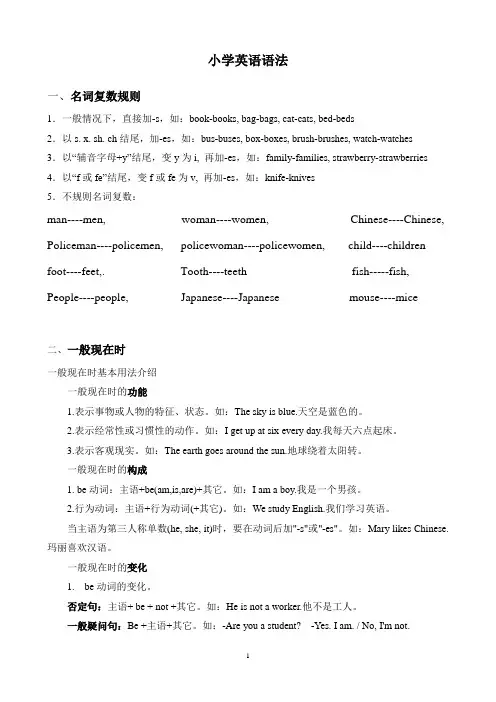
小学英语语法一、名词复数规则1.一般情况下,直接加-s,如:book-books, bag-bags, cat-cats, bed-beds2.以s. x. sh. ch结尾,加-es,如:bus-buses, box-boxes, brush-brushes, watch-watches3.以“辅音字母+y”结尾,变y为i, 再加-es,如:family-families, strawberry-strawberries 4.以“f或fe”结尾,变f或fe为v, 再加-es,如:knife-knives5.不规则名词复数:man----men, woman----women, Chinese----Chinese, Policeman----policemen, policewoman----policewomen, child----children foot----feet,. Tooth----teeth fish-----fish, People----people, Japanese----Japanese mouse----mice二、一般现在时一般现在时基本用法介绍一般现在时的功能1.表示事物或人物的特征、状态。
如:The sky is blue.天空是蓝色的。
2.表示经常性或习惯性的动作。
如:I get up at six every day.我每天六点起床。
3.表示客观现实。
如:The earth goes around the sun.地球绕着太阳转。
一般现在时的构成1. be动词:主语+be(am,is,are)+其它。
如:I am a boy.我是一个男孩。
2.行为动词:主语+行为动词(+其它)。
如:We study English.我们学习英语。
当主语为第三人称单数(he, she, it)时,要在动词后加"-s"或"-es"。
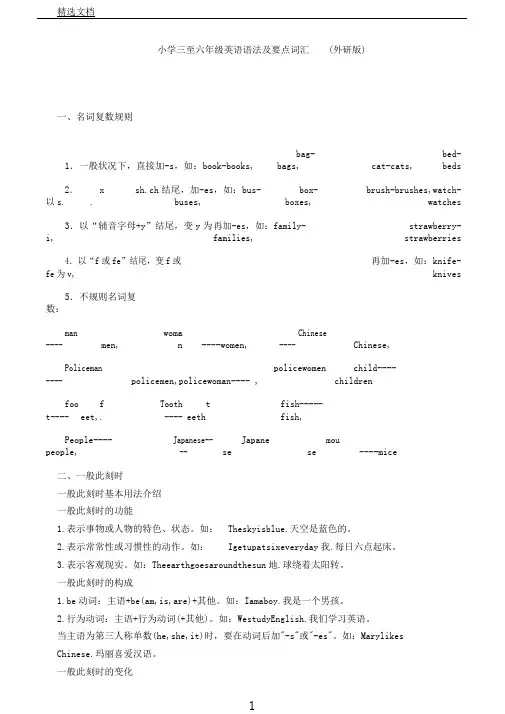
小学三至六年级英语语法及要点词汇(外研版) 一、名词复数规则1.一般状况下,直接加-s,如:book-books,bag-bags,cat-cats,bed-beds2.以s.x.sh.ch结尾,加-es,如:bus-buses,box-boxes,brush-brushes,watch-watches3.以“辅音字母+y”结尾,变y为i,再加-es,如:family-families,strawberry-strawberries4.以“f或fe”结尾,变f或fe为v,再加-es,如:knife-knives5.不规则名词复数:man----men,woman----women,Chinese----Chinese,Policeman----policemen,policewoman----policewomen,child----childrenfoo t----feet,.Tooth----teethfish-----fish,People----people,Japanese----Japanesemouse----mice二、一般此刻时一般此刻时基本用法介绍一般此刻时的功能1.表示事物或人物的特色、状态。
如:Theskyisblue.天空是蓝色的。
2.表示常常性或习惯性的动作。
如:Igetupatsixeveryday我.每日六点起床。
3.表示客观现实。
如:Theearthgoesaroundthesun地.球绕着太阳转。
一般此刻时的构成1.be动词:主语+be(am,is,are)+其他。
如:Iamaboy.我是一个男孩。
2.行为动词:主语+行为动词(+其他)。
如:WestudyEnglish.我们学习英语。
当主语为第三人称单数(he,she,it)时,要在动词后加"-s"或"-es"。
如:Marylikes Chinese.玛丽喜爱汉语。
一般此刻时的变化be动词的变化。
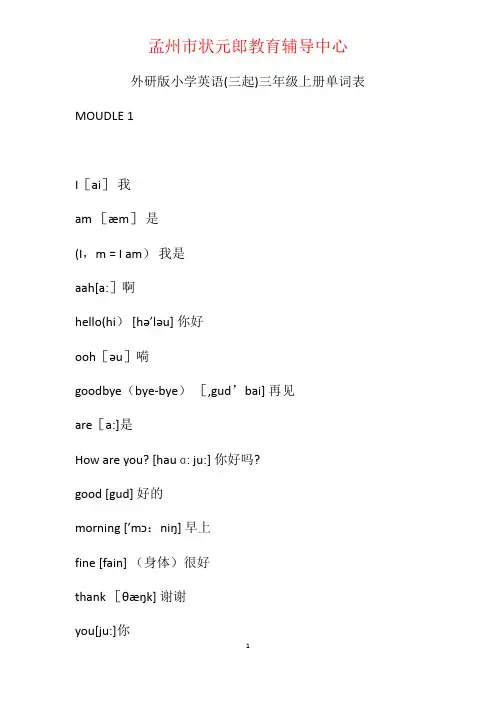
外研版小学英语(三起)三年级上册单词表MOUDLE 1I[ai]我am [æm]是(I,m = I am)我是aah[a:]啊hello(hi) [hə’ləu] 你好ooh[əu]嗬goodbye(bye-bye)[,gud’bai] 再见are[a:]是How are you? [hau ɑ: ju:] 你好吗?good [gud] 好的morning [’mɔ:niŋ]早上fine [fain] (身体)很好thank [θæŋk]谢谢you[ju:]你MODULE 2Ms [miz] 女士boy [bɔi]男孩girl [gə:l]女孩whoops[wups]哎哟and [ænd] 那么、和too [tu:]也what [wɔt] 什么is [iz]是(what,s = what is)是什么your [jɔ:] 你的name [neim]名字please [pli:z]请afternoon [’ɑ:ftə'nu:n] 下午Mr [mistə] 先生MODULE 3point [pɔint]to[tu:]the [ðə]这个,那个,这些,那些door [dɔ:] 门sit [sit]坐down [daun]向下stand [stænd] 站up [ʌp] 向上indow [’windəu]窗户blackboard [’blækbɔ:d] 黑板bird [bə:d]鸟desk [desk]桌子chair [tʃɛə]鸟MODULE4it [it]它(it,s = it is)它是red [red] 红色的look [luk] 看wow [wau]呀,哇yellow [’jeləu] 黄色的blue [blu:]蓝色的a(an)[ə] [æn]一(个)chanmeleon [kə’mi:liən]变色龙my [mai]我的panda ['pændə]熊猫now[nau]现在green [gri:n] 绿色的black [blæk]黑色的dog [dɔg] 狗cat [kæt] 猫cap[kæp]帽子MODULE 5many ['meni]许多how many 有多少one [wʌn]一two [tu:] 二three [θri:]三four [fɔ:] 四five [faiv] 五six [siks] 六seven ['sevn] 七eight [eit]八nine [nain]九oh [əu]噢,哦ten [ten] 十eleven [i’levn]十一twelve [twelv]十二MODULE6happy ['hæpi]快乐birthday [’bə:θdei]生日here [hiə]这里(here,s = here is) 这是present [prezent]礼物this [ðis]这个pencil['pensl] 铅笔cake [keik]蛋糕old [əuld]年岁yes [jes] 是的you’re =you are你是 [juə] [ju: a:]MODULE 7teacher ['ti:tʃə]教师pupil [’pju:pl] 小学生school [sku:l]学校classroom ['klɑ:srum]教室English ['iŋgliʃ]英语that [ðæt]那个say [sei] 说again [əˈɡein]再一次schoolbag [ˈsku:lˌbæg]书包ball [bɔ:l] 球book [buk] 书MODULE 8monster [ˈmɔnstə] 怪物new [nju:]新的kite [kait] 风筝or [ɔ:] 或者 don't = do not [dəunt]not[nɔt]不(isn,t = is not)不(不是)help [help]帮助救命where [wɛə]哪里(where,s = where is)在哪里in [in]在……里面bag [bæg]袋子MODULE 9mother [’mʌðə]母亲father [’fɑ:ðə]父亲sister ['sistə] 姐妹brother [’brʌðə]兄弟she [ʃi:]她(she,s = she is)(她是)grandpa [’grændpɑ:] 祖父,外祖父 grandma ['grændmɑ:]祖母,外祖母 that’s = that is 那是[ðæts]me [mi:]我(宾格)he[hi:]他(he,s = he is)他是doctor ['dɔktə]医生policeman [pə’li:smən] 警察nurse [nə:s]护士driver [’draivə] 司机farmer ['fɑ:mə]农民farmer [’fɑ:mə] 农民MODULE 10his[hiz] 他的head[hed] 头leg [leg]腿foot [fut]脚on [ɔn] 在.。
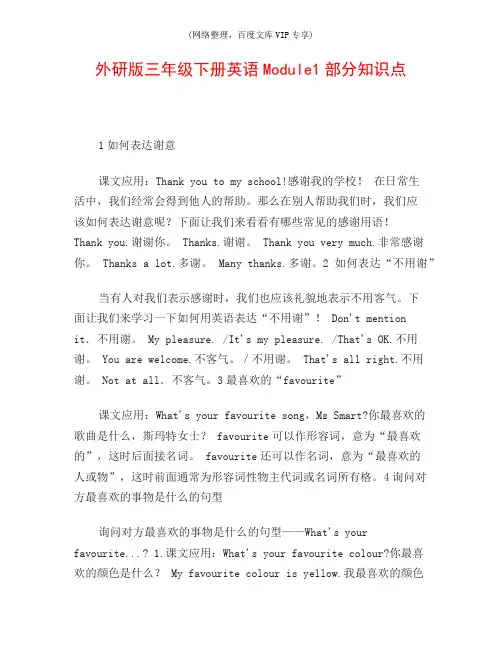
外研版三年级下册英语Module1部分知识点1如何表达谢意课文应用:Thank you to my school!感谢我的学校!在日常生活中,我们经常会得到他人的帮助。
那么在别人帮助我们时,我们应该如何表达谢意呢?下面让我们来看看有哪些常见的感谢用语!Thank you.谢谢你。
Thanks.谢谢。
Thank you very much.非常感谢你。
Thanks a lot.多谢。
Many thanks.多谢。
2如何表达“不用谢”当有人对我们表示感谢时,我们也应该礼貌地表示不用客气。
下面让我们来学习一下如何用英语表达“不用谢”! Don't mention it.不用谢。
My pleasure. /It's my pleasure. /That's OK.不用谢。
You are welcome.不客气。
/不用谢。
That's all right.不用谢。
Not at all.不客气。
3最喜欢的“favourite”课文应用:What's your favourite song,Ms Smart?你最喜欢的歌曲是什么,斯玛特女士? favourite可以作形容词,意为“最喜欢的”,这时后面接名词。
favourite还可以作名词,意为“最喜欢的人或物”,这时前面通常为形容词性物主代词或名词所有格。
4询问对方最喜欢的事物是什么的句型询问对方最喜欢的事物是什么的句型——What's your favourite...? 1.课文应用:What's your favourite colour?你最喜欢的颜色是什么? My favourite colour is yellow.我最喜欢的颜色是黄色。
2.句型结构:问句:What's your favourite+事物类别(song,food...)? 答语:My favourite+事物类别(song,food...)+is+具体事物(the ABC song,rice...)./(It's+)具体事物. 3.重点解析:此问句用于询问对方最喜欢的事物是什么。
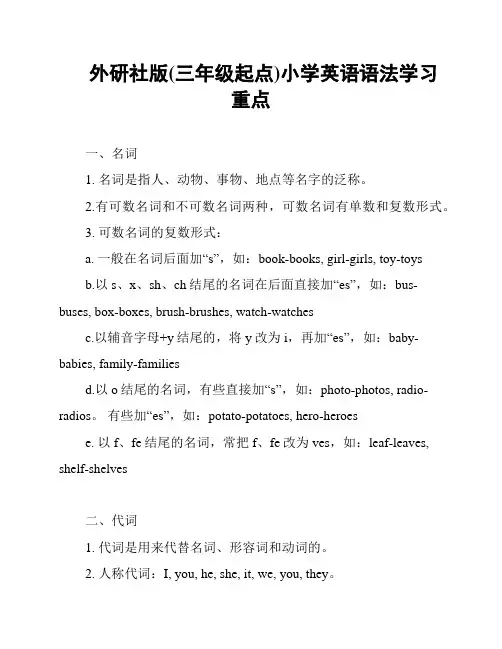
外研社版(三年级起点)小学英语语法学习重点一、名词1. 名词是指人、动物、事物、地点等名字的泛称。
2.有可数名词和不可数名词两种,可数名词有单数和复数形式。
3. 可数名词的复数形式:a. 一般在名词后面加“s”,如:book-books, girl-girls, toy-toysb.以s、x、sh、ch结尾的名词在后面直接加“es”,如:bus-buses, box-boxes, brush-brushes, watch-watchesc.以辅音字母+y结尾的,将y改为i,再加“es”,如:baby-babies, family-familiesd.以o结尾的名词,有些直接加“s”,如:photo-photos, radio-radios。
有些加“es”,如:potato-potatoes, hero-heroese. 以f、fe结尾的名词,常把f、fe改为ves,如:leaf-leaves, shelf-shelves二、代词1. 代词是用来代替名词、形容词和动词的。
2. 人称代词:I, you, he, she, it, we, you, they。
3. 物主代词:my, your, his, her, its, our, your, their。
4. 指示代词:this, that, these, those。
三、动词1. 动词表示动作或状态,及时态和语态。
2. 现在时态:a. 一般现在时,一般在动词原形后面加s,第三人称单数;b. 现在进行时,be动词+现在分词;c. 现在完成时,have/has+过去分词3. 过去时态:a. 一般过去时,动词过去式;b. 过去进行时,was/were+现在分词;c. 过去完成时,had+过去分词。
四、形容词1. 形容词用来描述名词的性质。
2. 形容词的比较级和最高级:a. 有些在形容词后面加-er, -est,如:big-bigger-biggest;b. 有些变形特殊,如:good-better-best。
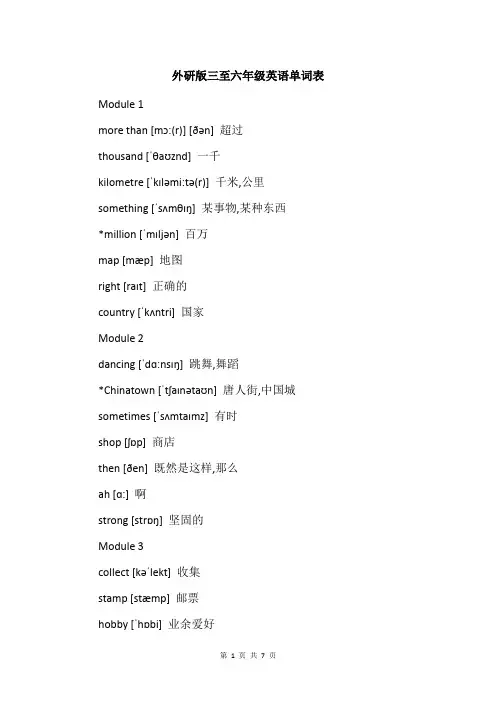
外研版三至六年级英语单词表Module 1more than [mɔ:(r)] [ðən] 超过thousand [ˈθaʊznd] 一千kilometre [ˈkɪləmi:tə(r)] 千米,公里something [ˈsʌmθɪŋ] 某事物,某种东西*million [ˈmɪljən] 百万map [mæp] 地图right [raɪt] 正确的country [ˈkʌntri] 国家Module 2dancing [ˈdɑ:nsɪŋ] 跳舞,舞蹈*Chinatown [ˈtʃaɪnətaʊn] 唐人街,中国城sometimes [ˈsʌmtaɪmz] 有时shop [ʃɒp] 商店then [ðen] 既然是这样,那么ah [ɑ:] 啊strong [strɒŋ] 坚固的Module 3collect [kəˈlekt] 收集stamp [stæmp] 邮票hobby [ˈhɒbi] 业余爱好*doll [dɒl] 玩具娃娃bicycle [ˈbaɪsɪkl] 自行车Module 4*Thanksgiving(Thanksgiving Day) [ˌθæŋks\'ɡɪvɪŋ] 感恩节flag [flæg] 旗;国旗Flag Day(美国)国旗制定纪念日fly [flaɪ] (使)(旗帜)飘扬special [ˈspeʃl] 特殊的,特别的meal [mi:l] 餐sound [saʊnd] 听起来football [ˈfʊtbɔ:l] (美式)橄榄球moon cake [mu:n keik] 月饼the Mid-Autumn Festival中秋节[ðə] [mɪd ˈɔ:təm] [ˈfestɪvl]the Dragon Boat Festival端午节[ðə] [ˈdræɡən bəut] [ˈfestɪvl] race [reɪs] 比赛,竞赛*lantern [ˈlæntən] 灯笼the Lantern Festival元宵节hang [hæŋ] 悬挂,吊Module 5pen friend [pen frend] 笔友Pleased to meet you!很高兴见到你![pli:zd] [tu] [mi:t] [ju]address [əˈdres] 地址French [frentʃ] 法语age [eɪdʒ] 年龄story [ˈstɔ:ri] 故事candy [ˈkændi] 糖果Module 6world [wɜ:ld] 世界often [ˈɒfn] 经常difficult [ˈdɪfɪkəlt] 困难的knife [naɪf] 餐刀;刀子fork [fɔ:k] 餐刀;叉chopsticks [\'tʃɒpstɪks] (常复)筷子Japanese [ˌdʒæpə\'ni:z] 日本的Module 7believe [bɪˈli:v] 相信snake [sneɪk] 蛇*DVD数字化视频光盘,DVD光盘together [təˈgeðə(r)] 一起,共同lucky [ˈlʌki] 幸运的bamboo [ˌbæmˈbu:] 竹子its [ɪts] 它的body [ˈbɒdi] 身体come out of [kʌm aut ɔv] 从……中出来*flute [flu:t] 笛子get [get] 变得,变成frightened [ˈfraɪtnd] 恐惧的,害怕的Module 8long ago [lɔŋ əˈɡəu] 很久以前I’d love to我很乐意not really [nɒt] [ˈri:əli] 不全是,事实上没有stop [stɒp] (使)停止clean [kli:n] 打扫,(使)清洁camera [ˈkæmərə] 照相机show [ʃəʊ] 把……给(某人)看never [ˈnevə(r)] 从不Module 9around [əˈraʊnd] 在四周,到处all around [ɔ:l əˈraund] 到处,遍及member state [ˈmembə steit] 成员国inside [ˌɪnˈsaɪd] 向室内,向里面should [ʃʊd] 应该Module 10line [laɪn] (等候的)长队,队列stand in line [stænd in lain] 排队close [kləʊz] 关门,关闭librarian [laɪˈbreəriən] 图书馆管理员rule [ru:l] 规定,规章quiet [ˈkwaɪət] 安静的problem [ˈprɑ:bləm] 麻烦,困难,问题No problem没问题cross [krɒs] 穿过(马路等);渡过(河)六年级下册单词表Module 1look [lʊk] 看上去cashier [kæˈʃɪə(r)] 收银员cola [ˈkəʊlə] 可乐dollar [ˈdɒlə(r)] 美元cent [sent] 美分enjoy [ɪnˈdʒɔɪ] 享用,享受careful [ˈkeəfl] 小心的Be careful! [bi: ˈkɛəful] 当心! Module 2later [ˈleɪtə(r)] 后来,以后to go剩余duck [dʌk] 鸭子pond [pɒnd] 水池,池塘cloud [klaʊd] 云dry [draɪ] 干的like [laɪk] 像......一样look like [luk laik] 看来好像stay [steɪ] 保持,维持Module 3shine [ʃaɪn] (太阳)发光,照耀cry [kraɪ] 哭everyone [ˈevriwʌn] 人人,每人;大家fly away [flai əˈwei] 飞走just [dʒʌst] 就,且请cow [kaʊ] 奶牛blow [bləʊ] 吹,刮rabbit [ˈræbɪt] 兔子Module 4balloon [bəˈlu:n] 气球stairs [steəz] (常复)楼梯mess [mes] 肮脏;凌乱Module 5play [pleɪ] 演奏third [θɜ:d] 第三(个)time [taɪm] 次,回bark [bɑ:k] (狗)吠,叫loudly [laʊdlɪ] 大声地nothing [ˈnʌθɪŋ] 没有东西,没有事情。
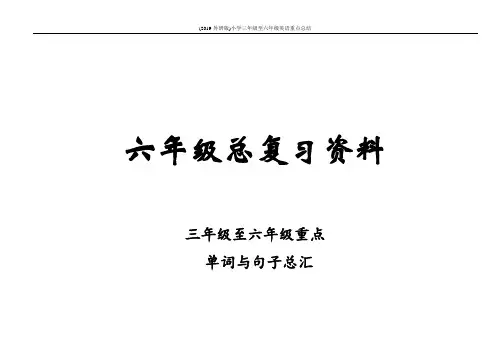
六年级总复习资料三年级至六年级重点单词与句子总汇三年级上册单词(2013版)Module11.I我2.(I’m=Iam)am是(我是)3.aah啊4.hello你好5.ooh嗬6.goodbye再见7.are是8.How are you你好么?你好!9.good好的10.morning早晨,上午11.fine 健康的12.thank谢谢13.you你Module21.Ms女士2.boy男孩3.girl女孩4.whoops哎呦5.and那么,和6.too也7.ha ha 哈哈8.wha什么9.is是(是什么)10.your你名字12.please请13.afternoon 下午14Mr先生Module31.point指2.to向……3.the这个,这些4.door门5.sit坐6.down向下7.stand站8.up向上9.window窗户10.blackboard黑板11.bird鸟12.tweet(鸟)啾啾的叫声13.desk书桌14.chair椅子module41.it它2.it’s=it is它是3.red红色的4.look看5.wow呀,哇6.yellow黄色的7blue 蓝色的8.a(an)一个,一9.chameleon变色龙10.my我的11.panda熊猫12.now 现在13.green绿色的14.black黑色的15.dog狗16.cat猫17.cap帽子module5.1.how many多少2.one一3.two二4.three三5.four四6.five五7.six六8.seven 七9.eight八10.nine九11.oh噢,哦12.ten十13.eleven十一14.twelve十二module61.happy快乐2.birthday生日3.here这里(这是)4.present礼物5this这个6.pencil 铅笔7.pen钢笔8.cake蛋糕9.old……岁的10.how old多大11.yes是的module7 1.teacher教师2.pupil小学生3.school学校4.classroom教师5.English英语6.that 那个7.say说8.again再一次9.schoolbag书包10.ball球11book书module81.monster怪物2.new新3.kite风筝4.or或5.don’t=do not不6.know知道7.no8.not9.help救命10.where哪里11.in在……里12.bag包module91.mother母亲2.father父亲3.sister姐妹4.brother兄弟5.she她(她是)6.grandpa 祖父7.grandma祖母8.that’s=that is那是9.me我10.he他11.doctor医生12.policeman警察13.nurse护士14.driver司机15.farmer农民module101.his他的2.head头3.leg腿4.foot脚5.on在……上6.arm胳膊7.hand手8.her 她的9.nose鼻子10.eye眼睛11.mouth嘴三年级英语下册单词(2013版)MODULE11.favourite 特别喜欢的2.song 歌曲3.toy 玩具4.ship 轮船5.car 小汽车6.doll 洋娃娃MODULE21. they 他们2.tiger 老虎3.big 大的4.lion 狮子5.elephant 大象6. monkey 猴子7.small小的8.fat 胖的9.short 矮的10.tall 高的11.thin 瘦的12.tree 树MODULE 31.like 喜欢2.football足球3.basketball 篮球4.table tennis乒乓球5.swimming 游泳6.skipping rope 跳绳MODULE 41.pass 传,递2.rice 米饭3.Mum 妈妈4 .meat 肉5.noodles 面条6.fish鱼k 牛奶8.banana 香蕉9.apple 苹果10.pear梨11.orange 橘子MODULE 51.get up 起床2.at 在...3.o’clock 点钟4.go to school 上学5.have lunch 吃午饭6.go home 回家7.watch TV 看电视8.go to bed 上床睡觉9.half 一半10.past 超过11.have breakfast 吃早饭12.have dinner 吃晚饭MODULE 6 1.do 做2.weekend 周末3.Chinese 语文,汉语4.Maths 数学5.Science 科学6.play 打(球)7.sleep 睡觉8.today 今天9.Music 音乐10.Art 美术11.PE 体育MODULE 71、1. for 给,为2.about 关于3.Spring 春节4.New Year新年5.Christmas圣诞节 6.England 英国MODULE 81.hot 热的2.summer 夏天3.spring 春天4.warm 暖和的5.fly 放(风筝)6.autumn 秋天7.cool 凉爽的8.winter 冬天9.cold 寒冷的10.sunny 晴朗的,阳光充足的11.windy 有风的MODULE 91. have got 拥有2.animal 动物3.sport运动4.dress 连衣裙,女装5.coat 外套6.sweater 毛线衫7.has got 拥有(have got的第三人称单数形式)8.T-shirt T 恤衫9.by 乘坐,以……方式10.bike 自行车11.bus 公共汽车12.go to work 上班13.walk 步行MODULE 101. on 在……上面2.box 盒子3.under 在……下面4.bedroom 卧室5.park 公园6.swim 游泳ke 湖8.snow 雪四年级上册总结(2013版)Module 1一、单词1. straight直地,直线地 2.go straight on 直着走3.left 左边;向左;左边的 4.right 右边;向右;右边的 5. lost 迷路的 6. live 居住 7. No. (number的缩写) 8. street大街,街道 9.excuse me 对不起,打扰一下10.turn left 向左转11. turn right 向右转 12. next to 紧靠……旁边,贴近 13.supermarket 超市14.beside 在……旁边,在……附近 15.cinema 电影院 16.so much 十分,非常 17.You are welcome! 不客气 18.station车站19.train火车 20.hill 小山21.near 接近,临近 22.house 房屋二、短语1.go straight on.2. turn left3.turn right4.next to .5.up the hill6.down the hill7.near the houses8. at the station 10.excuse me三、句型重点1.A:Excuse me!Where’s ..., please?B:It’s next to \beside a supermarket.2.Go straght on. Turn left. Turn right.3.A:Thank you so much.B:You’re welcome.四、句型结构1.问路:Excuse me!Where’s ..., please?2.描述具体的方位级位置:It’s next to \beside...t..2.指路:Go straght on. Turn left. Turn right.五、语法一般现在时Module 2一、单词1.read 读,阅读 2.running跑步 3.these 这些 4. picture 照片5. take 拍摄 6. take picture 照相 7. children(child 的复数形式)孩子们8. listen 听 9. listen to 听 10. talk 说话,交谈 11.talk to和…..交谈 12. China 中国二、短语1.take pictures2.listen to3.talk to三、句型重点1. This is my…2.She's reading a book/taking pictures /watching TV/playing with a toy train.3. What are you doing ? I’m listening to music.4. I like playing football. She likes playing basketball. Hes likes swimming. We likerunning.Like+动词ing 第三人称like+s第三人称是指he/ she 某个人如:我爸爸,我妈妈,大明,艾米……四、句型结构1.介绍自己的家人朋友This is my…2. 描述他人正在做某事Panpan /He/She is +动词ing形式五、语法现在进行时Module 3一、单词1. kid 小孩 2. get on 上(车) 3.can 能够,会 4. see 看到 5. lots of 许多 6. interesting 有趣的 7. thing 东西,物品;事情8. people人,人们9. row 划(船)10. dragon龙 11.boat船 12.dragon boat 龙舟 14.men (man的复数形式)男人15.between 在……之间,在中间 16.chess 国际象棋17. play chess 下国际象棋18. drink 喝,饮19. soya milk 豆浆 20. clock 钟21. hungry 饥饿的22. Me too. 我也一样23. draw 画 24. jump 跳25. sing 唱歌26. dance 跳舞二、短语1get on 2 lots of 3 look at 4 in the park 5on the lake 6under the tree 7 dotaijiquan 8 row a dragon boat 9 play chess 10 drink soybean milk 11 me too三、句型重点A:What are they doing?B: They’re play ing chess.A:What’s she doing?B;She’s running.A:What’s he doing?B:He’s swimming.A:What are you doing?B:I’m making dumplings.A: What is the bird doing?B: It’s singing.A: What are the tigers doing?B: They’re jumping.四、句型结构1.询问他人正在什么:what are you doing?2. 描述人们正在做的事情:They are 动词ing形式五、语法现在进行时Module 4一、单词1. want 想要 2. some 一些 3. juice 果汁 4. ice 冰 5.also 也,还 6.food 食物 7. fast food 快餐 8. make 制作9.tomato 番茄,西红柿 10. egg 鸡蛋11.potato 马铃薯,土豆 12.How much…? ……多少钱? 13.flower花 14. dumpling 水饺 16. help 帮助,帮忙 17.buy 买二、短语1.make noodles2.how much 三、句型重点1.A:Do you want some rice? B:Yes, please. /No, thank you.2.A:What is he doing? B:He is making noodles.3. There are Noodles with tomato and egg, and noodles with potato and meat.3.A:How much is it? B:It's ten yuan.4. Can I help you? We want some eggs.5. Can we help you? Of course.四、句型结构1.询问他人是否想要某种食物Do you want some…? Yes, please./ No,thank you.2.询问某物的价格:How much is it?3.There be 句型五、语法一般现在时Module 5一、单词1. run 跑,奔跑 2. fast 快,快速地 3. sky 天,天空 4. high高高地 5. winner 获胜者 6.far远 7. afraid 恐怕8. strong 健壮的 9. star 明星二、短语1.run fast2.jump high3.ride fast4.jump far 6.in the sky三、句型重点1.A:Can you run fast / jump high / ride fast?B:Yes, I can ./ No, I can’t.2. You can't jump high.3. I can jump high. Can you? Yes, I can. / No, I can’t.4. Can Sam play football ? Yes, he can. / No, he can’t.5. Can Lingling run fast? Yes, she can. / No, she can’t.四、句型结构1.描述自己和他人能做什么和不能做什么I/He/She can+动词原形I/He/Shecan't +动词原形 2.询问他人能做什么及对别人的询问作肯定回答或否定回答Can you he/she/Sam+动词原形?Yes, I /she /he can. /No,I/she/he can.五、语法一般现在时(注意人称)Module 6一、单词 1. sweets(常复)糖果 2.soup 汤 3.sorry 抱歉,对不起 4. bread 面包5. dark 黑暗的6.well (语气词)唔,噢7. turn on打开8. light 灯9. Halloween 万圣节前夕10. trick or treat 不请吃就捣蛋 11.give 给 e in 进来 13.of course 当然二、短语1. have some soup2. have some sweets3. have some bread4. very hungry5. come here6. very dark7. turn on turn on the light /turn off8. Happy birthday!9. some fruits / some cake 10. come in 11. of course 12. here you are 13. Happy Halloween三、句型重点1. Can I have some soup? Yes, you can./No, you can't. /.2. Today is halloween.3. Can I come in? Yes, of course./ Sorry , you can’t.4. Do you want some bread? Yes, please. / No, thank you.四、句型结构1.是否能吃某物:Can I have some…?2. 询问是否能做某事:Can I +动词原形+其他?Yes, you can./Sorry you can'.3. 询问别人是否要某物:Do you want …五、语法一般现在时Module 7 一、单词1. there is 有,存在2. horse 马 3.there are 有,存在4. have a look 看一看 5. sheep羊,绵羊 6. vegetable 蔬菜7. climb 爬,攀爬8. face 脸,面孔9. fruit 水果 10.chicken 鸡 11. bear 熊 12. pig 猪二、短语1.have a look2.there are3. there is4. in the photo5. climb a tree6. eat vegetables /fruit /rice7.under the tree8.watch a cat9.ride a horse 10. fly a kite 11. on the bike三、句型重点1.Let's have a look.2.There are some nice photos here.3. There is a horse in this photo.四、句型结构1.there be 句型用于某地有某物:There is +单数可数名词或不可数名词+其他there are+可数名词复数+其他五、语法There be句型Module 8一、单词1. visit参观,拜访2.tomorrow 明天3. plane 飞机 4. get up 起床5. o'clock……点钟6. from来自……7.sea大海8.swimsuit 游泳衣9.sock短袜10.fish 鱼,钓鱼,捕鱼11. hooray(表示激动与高兴的呼喊声)好,好哇二、短语1get up 2. by plane/ train /bike 3. go to swim 4. in the park 5.take some pictures 6. go to fish三、句型重点1. Time for bed.2. We're going to visit Hainan tomorrow.We’re going to by plane.3.I'm from the UK.4. What are you going to do? I’m going to swim.5.This is Xiaoyong’s bag.6. What is it going to do? It’s going to fish.7. What is Sam/ Amy going to do ? Sam is going to fly a kite. /Amy is going to ride a horse.四、句型结构1,描述自己所在团体的近期计划We're going to +动词原形2.描述自己和他人的近期计划I'm /he's/she's going to +动词原形3. 介绍自己来自何处:I’m from...五、语法一般将来时Module 9一、单词1. sports day运动日2. win胜利,取胜3.month月 4.hundred一百(100)5. metre米6. every每个,每一7.day一天,一日8.luck 运气9. good luck祝你好运10. come on快点,赶快11.jump跳12. high jump跳高13.long jump跳远14.how about…?......怎么样?15. subject学科,科目二、短语1high jump 2long jump 3come on 4how about 5good luck三、句型重点1.We're going to have a sports day this month.2.Are you going to run on sports day? Yes, I am. / No, I’m not.3. Good luck.4. What are you going to do ?-- We're/I'm going to ...5. I’m going to run the 100 metres.6. What are you going to do on sports day? I’m going to do thd high jump.四、句型结构1确认他人计划:Be+主语+going to…? 肯定回答Yes, 主语+be. 否定回答No,主语+be+not 2学习goodluck和come on的用法 3.描述自己的计划,并对他人的进行询问:What are you going to do ?-- We're/I'm going to+动词原形五、语法一般将来时Module 10一、单词1. family家,家庭 2. dinner晚餐,正餐3. year年份 4. New Year新年 5. Chinese中国的6. festival节日7. the spring festival春节8.I see我明白了9. peanut花生10. merry愉快的11. Christmas圣诞节12. Merry Christmas!圣诞快乐!二、短语1.New year2.the Spring Festival3. Chinese New Year4. sing songs5. give presents6.lots of food三、句型重点1.Here's a book for you.2.What's it about?---It’s about the Spring Festival.3. What is the Spring Festival?4.At the Spring Festival we have a big family dinner.5.We have peanuts and sweets.6. It’s the Chinese New Year.7.Happy New Year.8. What do you do at Christmas?四、句型结构1.在新年时正确地向对方表示祝贺Happy+节日名称。
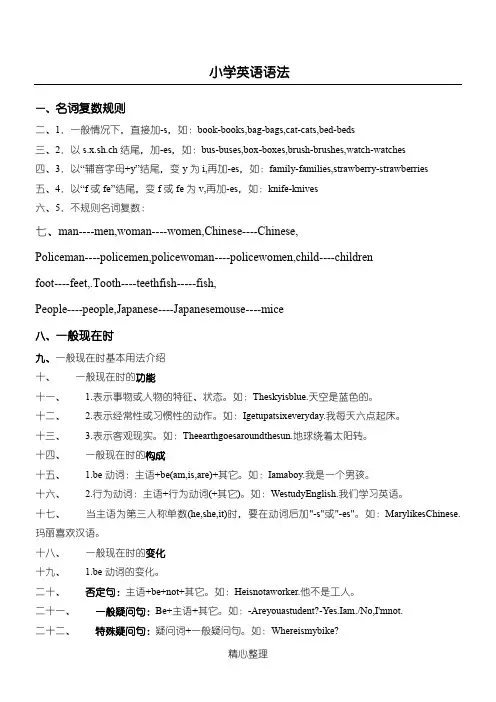
小学英语语法一、名词复数规则二、1.一般情况下,直接加-s,如:book-books,bag-bags,cat-cats,bed-beds三、2.以s.x.sh.ch结尾,加-es,如:bus-buses,box-boxes,brush-brushes,watch-watches四、3.以“辅音字母+y”结尾,变y为i,再加-es,如:family-families,strawberry-strawberries五、4六、5七、八、九、十、十一、十二、十三、十四、十五、十六、十七、当主语为第三人称单数(he,she,it)时,要在动词后加"-s"或"-es"。
如:MarylikesChinese.玛丽喜欢汉语。
十八、一般现在时的变化十九、 1.be动词的变化。
二十、否定句:主语+be+not+其它。
如:Heisnotaworker.他不是工人。
二十一、一般疑问句:Be+主语+其它。
如:-Areyouastudent?-Yes.Iam./No,I'mnot.二十二、特殊疑问句:疑问词+一般疑问句。
如:Whereismybike?二十三、2.行为动词的变化。
否定句:主语+don't(doesn't)+动词原形(+其它)。
如:Idon'tlikebread.当主语为第三人称单数时,要用doesn't构成否定句。
如:Hedoesn'toftenplay.一般疑问句:Do(Does)+主语+动词原形+其它。
如:-Doyouoftenplayfootball?-Yes,Ido./No,Idon't.当主语为第三人称单数时,要用does构成一般疑问句。
如:3.动词+s12.以3.以“12345疑问词???????????动词加ing的变化规则1.一般情况下,直接加ing,如:cook-cooking2.以不发音的e结尾,去e加ing,如:make-making,taste-tasting3.如果末尾是一个元音字母和一个辅音字母,双写末尾的辅音字母,再加ing,如:run-running,stop-stopping四、将来时1、概念:表示将要发生的动作或存在的状态及打算、计划或准备做某事。
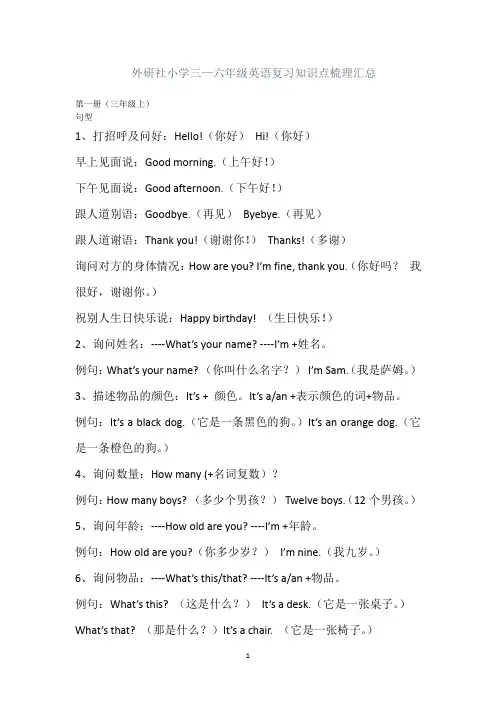
外研社小学三—六年级英语复习知识点梳理汇总第一册(三年级上)句型1、打招呼及问好:Hello!(你好)Hi!(你好)早上见面说:Good morning.(上午好!)下午见面说:Good afternoon.(下午好!)跟人道别语:Goodbye.(再见)Byebye.(再见)跟人道谢语:Thank you!(谢谢你!)Thanks!(多谢)询问对方的身体情况:How are you? I’m fine, thank you.(你好吗?我很好,谢谢你。
)祝别人生日快乐说:Happy birthday! (生日快乐!)2、询问姓名:----What’s your name? ----I’m +姓名。
例句:What’s your name? (你叫什么名字?)I’m Sam.(我是萨姆。
)3、描述物品的颜色:It’s + 颜色。
It’s a/an +表示颜色的词+物品。
例句:It’s a black dog.(它是一条黑色的狗。
)It’s an orange dog.(它是一条橙色的狗。
)4、询问数量:How many (+名词复数)?例句:How many boys? (多少个男孩?)Twelve boys.(12个男孩。
)5、询问年龄:----How old are you? ----I’m +年龄。
例句:How old are you?(你多少岁?)I’m nine.(我九岁。
)6、询问物品:----What’s this/that? ----It’s a/an +物品。
例句:What’s this? (这是什么?)It’s a desk.(它是一张桌子。
)What’s that? (那是什么?)It’s a chair. (它是一张椅子。
)7、介绍某物/人:This is my + 物/人。
例句:This is my school.(这是我的学校。
)That is my classroom.(那是我的教室。
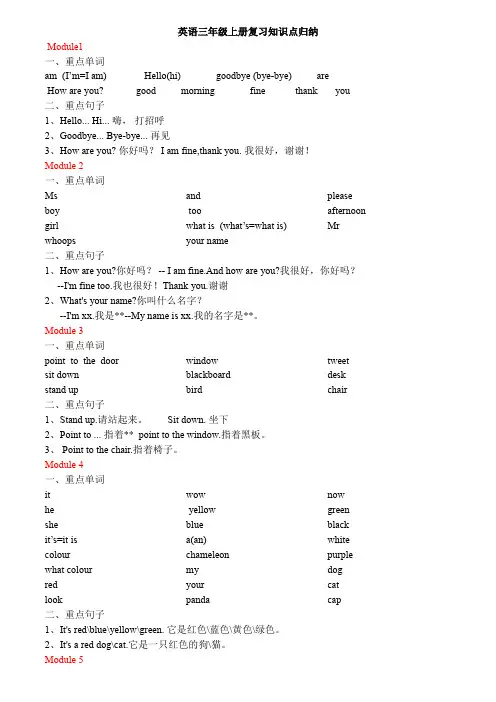
英语三年级上册复习知识点归纳Module1一、重点单词am(I’m=I am)Hello(hi)goodbye(bye-bye) are How are you?good morning fine thank you二、重点句子1、Hello...Hi...嗨,打招呼2、Goodbye...Bye-bye...再见3、How are you?你好吗?I am fine,thank you.我很好,谢谢!Module2一、重点单词Ms boy girl whoops andtoowhat is(what’s=what is)your namepleaseafternoonMr二、重点句子1、How are you?你好吗? -- I am fine.And how are you?我很好,你好吗? --I'm fine too.我也很好!Thank you.谢谢2、What's your name?你叫什么名字?--I'm xx.我是**--My name is xx.我的名字是**。
Module3一、重点单词point to the door sit downstand up windowblackboardbirdtweetdeskchair二、重点句子1、Stand up.请站起来。
Sit down.坐下2、Point to...指着**point to the window.指着黑板。
3、Point to the chair.指着椅子。
Module4一、重点单词ithesheit’s=it is colour what colour redlook wowyellowbluea(an)chameleonmyyourpandanowgreenblackwhitepurpledogcatcap二、重点句子1、It's red\blue\yellow\green.它是红色\蓝色\黄色\绿色。

外研社小学三-六年级英语复习知识点梳理汇总---CAL-FENGHAI.-(YICAI)-Company One1外研社小学三—六年级英语复习知识点梳理汇总第一册(三年级上)一、词汇常用物品:door, window, desk,chair, blackboard, schoolbag, pencil, pen, book, cap, present, cake, ball, kite(门,窗,桌子,椅子,黑板,书包,铅笔,钢笔,书,帽子,礼物,蛋糕,球,风筝)颜色:red, blue, yellow, green, black(红色,蓝色,黄色,绿色,黑色)动物:panda, dog, cat, bird, chameleon(熊猫,狗,猫,鸟,变色龙)数字:one, two, three, four, five, six, seven, eight, nine,ten,eleven, twelve(一,二,三,四,五,六,七,八,九,十,十一,十二)身体器官:head, leg, foot, arm, hand, nose, eye, mouth, ear(头,腿,脚,手臂,手,眼睛,鼻子,嘴巴,耳朵)家庭成员:mother, father, grandpa, grandma, sister, brother(妈妈,爸爸,爷爷,奶奶,姐姐,弟弟)职业:teacher, pupil, doctor, driver, nurse, farmer, policeman(老师,学生,医生,护士,司机,农民,警察)代词:I, you, it, me, he, she, your, my, his, her, this, that(我,你,它,我,他,她,你的,我的,他的,她的,这个,那个)二、句型1、打招呼及问好:Hello!(你好) Hi!(你好)早上见面说:Good morning.(上午好!)下午见面说:Good afternoon.(下午好!)跟人道别语:Goodbye.(再见) Byebye.(再见)跟人道谢语:Thank you!(谢谢你!) Thanks!(多谢)询问对方的身体情况:How are youI’m fine, thank you.(你好吗?我很好,谢谢你。
外研版小学英语(三起)三年级上册单词表MOUDLE 1I 我am 是(I,m = I am) 我是aah啊hello(hi) 你好ooh嗬goodbye(bye-bye)再见are是How are you 你好吗 good 好的morning 早上fine (身体)很好thank 谢谢you 你MODULE 2Ms 女士boy 男孩girl 女孩whoops 哎哟and 那么、和too 也what 什么is 是(what,s = what is)是什么your 你的name 名字please 请afternoon 下午Mr 先生MODULE 3point to the 这个,那个,这些,那些door 门sit 坐down 向下stand 站up 向上indow 窗户blackboard 黑板bird 鸟desk 桌子chair 鸟MODULE4it 它(it,s = it is) 它是red 红色的look 看wow 呀,哇yellow 黄色的blue 蓝色的a(an)一(个) chanmeleon 变色龙my 我的panda 熊猫now现在green 绿色的black 黑色的dog 狗cat 猫cap帽子MODULE 5many 许多how many 有多少one 一two 二three 三four 四five 五six 六seven 七eight 八nine 九oh 噢,哦ten 十eleven 十一twelve 十二MODULE6happy 快乐birthday 生日here 这里(here,s = here is) 这是present 礼物this 这个pencil 铅笔cake 蛋糕old年岁yes 是的you’re =you are你是MODULE 7teacher 教师pupil 小学生school 学校classroom 教室English 英语that 那个say 说again 再一次schoolbag 书包ball 球book 书MODULE 8monster 怪物new 新的kite 风筝or 或者don't = do not不not (isn,t = is not) 不(不是)help 帮助救命where 哪里(where,s = where is) 在哪里in 在……里面bag 袋子MODULE 9mother 母亲father 父亲sister 姐妹brother 兄弟she 她(she,s = she is)(她是)grandpa 祖父,外祖父grandma 祖母,外祖母that’s = that is 那是me 我(宾格)he他(he,s = he is) 他是doctor 医生policeman 警察nurse 护士driver 司机farmer 农民farmer 农民MODULE 10his 他的head头leg 腿foot脚on 在......上arm 手臂hand 手her 她的nose鼻子eye眼睛mouth 嘴ear 耳朵外研版小学英语(三起)三年级下册单词表MODULE1song 歌曲 TV 电视台 favourite 特别喜欢的 colour 颜色Here you are 给你MODULE2they 它(她、他)们 they’re=they are 他(她它)们是 monkey 猴子 baby 幼兽幼畜婴儿all 每个全体 zoo 动物园 tiger 老虎 lion 狮子elephant 大象 small 小的 fat 胖的 man short 矮的 tall 高的small 小的 short 矮的 thin 瘦的 big 大的MODULE 3like 喜欢 football 足球 them 它(她、他)们 ouch 哎呦 basketball 篮球 table tennis 乒乓球 morning exercises 早操 bike 自行车 swim 游泳 skip跳绳MODULE 4meat 肉 pass 传,递 rice 米饭 Mum 妈妈 noodles 面条(常复)fish 鱼 milk 牛奶 mm 呣 does do的第三人称单数 orange 橘子apple 苹果 banana 香蕉 pear 梨 doesn’t= does not 不MODULE 5goes (go的第三人称单数形式) 去,到 go to school 上学 on 表示位置)在…上; (表示时间)在…之时; (方式)通过 Monday 星期一 play 参加(体育活动比赛等) phone 电话电话机on the phone 通电话 with 与…..在一起同跟和 friend 朋友 at 在 home 家 at home 在家 who 谁only 只仅仅 year 年龄岁数 work 工作地点 go to work 上班Saturday 星期六shopping 购物 go shopping dad 爸爸MODULE 6do 做 Sunday 星期日 Swimming 游泳 go swimming 去游泳 eat 吃 in 在…..期间在…..时候 sleep 睡觉 watch 观看 TV 电视 watch TV 看电视 have 有 class 课班级 today 今天 Music 音乐 has (have 的第三人称单数形式) 做进行从事 Chinese 语文,汉语 Maths 数学 Art 美术 PE 体育 Science 科学MODULE 7we 我们 fly 放(风筝) spring 春天 summer 夏天season 季节 nice 迷人的令人愉快的 warm 暖和的 hot 热的autumn 秋天 cool 冷 winter 冬天 cold 寒冷的 sunny 晴朗的,阳光充足的 windy 有风的very 很非常MODULE 8toy 玩具 under在……下面 for 为给 box 盒子 behind 在….后面 bedroom 卧室 fly ( fly的第三人称单数形式) 放(风筝) park 公园 lake湖 tree 树 fishing 捕鱼钓鱼 go fishing 去钓鱼 walk 步行MODULE 9have got 拥有(have got的第三人称单数形式) sweater 毛线衫 bed 床 line 线 about 关于animal 动物 sport运动 haven’t(got)=have not(got) 没有 dress连衣裙,女装 coat 外套T-shirt T恤衫has got 拥有(have got的第三人称单数形式) hasn’t(got)=has not(got) 没有 by[bai]乘坐,以……方式 bus 公共汽车 car 小汽车MODULE 10hat 帽子 come 来 back 回到返回 come back 回来clothes (常复) 衣服 open 打开 let’s=let us 让我们 put on 穿上 funny 滑稽的 party 聚会 OK 好的 brown 褐色的棕色的trousers (常复)裤子 orange 橙色的橘黄色的 shirt 衬衫look at 看朝…..看 shoe 鞋 can’t=can not 不会 turn (多人一次轮流时)轮到的机会white 白色 photo 照片 skirt 女裙裙子外研版小学英语(三起)四年级上册单词表Module 1straight直地,直线地go straight on 直着走left 左边;向左;左边的right 右边;向右;右边的lost 迷路的live 居住No.(number的缩写)第……号street 大街,街道excuse 原谅excuse me对不起,打扰turn 转动,旋转turn left 向左转turn right 向右转next to临近的,在……旁边supermarket超市beside在……旁边,在……附近cinema电影院so much 十分,非常You`re welcome!不客气!station 车站train 火车hill 小山near 接近,临近house 房屋Module 2read 阅读running 跑步these 这些picture 图画take拍摄take pictures照相children (child的复数) 孩子们listen 听listen to听talk说话,交谈talk to 和……交谈China 中国Module 3Kid 小孩get on 上(车) can 能够 see看到 lots of许多interesting 有趣的thing 物品,东西people 人,人们row 划(船)dragon龙boat 船dragon boat龙舟men(man的复数)男人;between在……之间,在中间chess 国际象棋play chess 下国际象棋 drink 喝,饮用 soya milk豆浆 clock 钟 hungry 饥饿的Me too我也一样 draw 画 jump 跳 sing唱歌 dance 跳舞Module 4want 需要,想要 some 一些 juice果汁 ice冰,冰块 also也,还 food 食物fast food 快餐 make 制作 tomato 番茄,西红柿 egg 鸡蛋potato马铃薯,土豆 how much…......多少钱 flower 花 dumpling 水饺help帮助,帮忙 buy买Module 5run 跑 fast 快 sky 天,天空 high 高 winner 冠军 far 远Afraid 恐怕 strong 健壮的 star明星Module 6sweets (常复)糖果 soup 汤 sorry抱歉,对不起 bread 面包dark 黒暗的 well (语气词)唔,噢 turn on 打开 light灯Halloween 万圣节前夕 trick or treat 不请吃就捣蛋 give 给 come in 请进of course 当然Module 7there is 有,存在 horse马 there are 有,存在have a look看一看sheep 羊,绵羊vegetable 蔬菜climb爬,攀爬face脸,面孔fruit 水果chicken鸡bear熊pig猪Module 8 visit参观,拜访tomorrow 明天plane 飞机get up 起床o'clock ……点钟from 来自……sea 大海swimsuit 游泳衣sock 短袜fish 鱼,钓鱼,捕鱼hooray (表示激动与高兴的呼喊声)好,好哇Module 9sports day 运动日win胜利,取胜month月hundred一百(100)metre 米every 每个,每一day一天,一日luck 运气good luck祝你好运come on快点,赶快jump 跳high jump 跳高long jump 跳远how about… ......怎么样subject 学科,科目Module 10family家,家庭dinner晚餐,正餐year年份New Year新年Chinese中国的festival节日the spring festival春节I see我明白了peanut花生merry['meri]愉快的Christmas圣诞节Merry Christmas!圣诞快乐!外研版小学英语(三起)四年级下册单词表Module 1Nice 友好的,亲切的 clever 聪明的 naughty 淘气的 a bit 有一点shy 害羞的 answer接(电话) call 电话,打电话 bad 不好的,坏的 cool 酷的 aunt 阿姨;姑妈;伯母 uncle 叔叔,伯伯,舅父 big 年龄较大的 little 小的,年幼的 cute 可爱的Module 2city 城市 ship 船 beautiful美丽的 whose 谁的 queen 女王 close 近的,接近的old古老的 famous著名的Module 3robot 机器 will 将,将会 everything所有事情 one day (将来)有一天housework家务 learn学习 our 我们的 homework 家庭作业won't=will not 将不会 Monday星期一 Tuesday星期二 Wednesday星期三 Thursday星期四Friday星期五 Saturday星期六 Sunday星期日have 有,拥有 next 下一个的 week 星期,周 holiday 假期Module 4take 带走,拿走, fly 飞 picnic 野餐 great 太好了 why 为什么 Why not为什么不呢 because 因为 so 所以 cloudy 多云的 weather 天气Module 5was 是(am/is的过去式) then当时,那是 grandparent (外)祖父(母) were是,(are的过去式) young 年轻的 old 年长的 hair 头发so这么 ,那么 short短的 long 长的 wasn’t=was not不是 weren’t=were not不是 clean 干净的 dirty 脏的Module 6yesterday 昨天 out 不在家 well 健康的 thanks 谢谢sun 太阳 lesson 一堂课 village 乡村Module 7had( have的过去式)度过 phone 打电话 cook 烹饪,烧(菜) really 真的wash 洗 what about……怎么样 did(do的过去式)助动词 didn’t=did not 没有 computer 计算机;电脑 love 爱,喜欢 him 他(宾格) Mrs 太太;夫人 Miss 小姐Module 8sang 唱歌 beautifully 优美地 saw ( see的过去式)看见 game 游戏;比赛 last 最近过去的fun 有趣的事 went (go的过去式)去… there 在那儿ate (eat的过去式)吃 drank (drink的过去式)喝 time 一段时间have a good time玩得开心 busy 忙碌的 took (take的过去式)拍摄 tell 告诉great 非常好的 delicious 美味的;可口的 made (make的过去式)做,制成 poster海报,招贴画Module 9welcome 欢迎 postcard明信片 cousin 堂兄弟姊妹;表兄弟姊妹 dear 亲爱的 on holiday 在休假 travel 旅行 came come的过去式来pop 流行音乐 concert 音乐会 earth 地球Module 10 fall 掉下,落下 fall off 跌落 fell (fall的过去式) 掉下,落下 fall down 摔倒,跌倒 found 发现,找到 town 城镇,市镇 happen 发生 ride 骑,乘then 然后 thirsty 口渴 water 水 bought (buy)买外研版小学英语(三起)五年级上册单词表Module 1Met meet过去式)碰上,遇见 above 在.....上方,在.....之上 ground地面those那些ice cream冰激凌us(宾格)我们finish吃完wait等待,等候hurry 赶紧,匆忙hurry up赶紧,赶快dropped(drop过去式)(无意中)使掉落email电子邮件ran (run的过去式) 跑love爱你的Module 2List 清单 er 哦,嗯,呃need 需要first首先,第一;最先的,第一(次)的can可以lost(的过去式)丢失how much多少(用于不可数名词)*cheese 奶酪any一些,一点,若干use使用over there在那边bottle瓶子;一瓶的容量half一半kilo 千克,公斤a lot of许多的Module 3weekend周末place地方British英国的,英国人的,英国人museum博物馆how如何,怎样best最took(take的过去式)搭乘,乘坐(交通工具);需要花费(一定的时间)trip旅行,旅程along沿着river河,江hour小时twenty二十minute分钟of关于......的,表明......的wall墙,城墙arrive到达for达,计mountain山with 拥有,具有plant植物Module 4pair一套,一双,一副shorts(常复)短裤*argue争论,争吵 matter问题,麻烦 What’s the matter 怎么啦took(take的过去式)拿(走),取(走)wear 穿That’s OK没关系sports体育运动的,体育运动用的hey嘿,喂Module 5nineteen 十九crayon蜡笔fifteen 十五begin开始give out分发all right好,行thirteen 十三fourteen 十四sixteen 十六seventeen十七eighteen 十八floor地面,地板forty四十number数字thirty三十fifty五十sixty六十seventy七十eighty八十ninety九十happily幸福地,愉快地many许多,很多Module 6well 好,熟练地team运动队,球队really很,非常good at擅长catch抓住,接住*goalkeeper守门员think想,认为fantastic极好的fan狂热仰慕者,迷past过去swan(swim的过去式)游泳slow慢的healthy健康的Module 7a lot许多,大量useful有用的show(电视或广播)节目*presenter(电视或广播节目的)主持人deaf失聪的,聋的blind 失明的,瞎的hear听到her(宾格)她fire火灾,失火*firefighter消防队员hot dog热狗*sausage香肠kind友好的,善意的,体贴的Module 8time时刻,时候,时间school上课时间,上学时间start开始,发生past晚于,过(几点)late迟到的go to bed上床睡觉exercise 运动,锻炼playground 操场before在……之前join加入,参加Skipping rope 跳绳coffee咖啡tea茶always总是,一直bell钟,铃rang(ring过去式)鸣,响into进入......里面Module 9feel 感觉,觉得bored 厌烦的,厌倦的sad 伤心的,难过的woof(狗发出的)吠声miss 想念angry 生气的,愤怒的ill有病的,不健康的told(tell的过去式)告诉better痊愈的,恢复健康的farm 农场tired 累的,疲劳的won(win的过去式)赢,获胜ruler直尺smell闻出,嗅出Module 10kitchen厨房toilet厕所,卫生间,room房间living room起居室,客厅*hide-and-seek捉迷藏now[na ʊ] 好,哦last 最后hide 躲,躲藏sofa 沙发shout 呼喊,大叫grass草,草地baby婴儿dangerous 危险的外研社小学英语五年级下册(三年级起点)单词表Module 1Still还,仍然 Programme(电视或广播)节目 lady女士,夫人life生活 different不同的 ago以前 Interviewer采访者 enough 足够的 television电视机*grandchildren(grandchild的复数形式)(外)孙子(女) change改变,变化 night 夜晚,夜间 work工作;劳动;干活儿 field田地fire火炉火or( 用于否定句中)也不,也没 radio收音机 telephone电话 couldn`t=could not不能 write写 hope希望Module 2learnt(learn的过去式)学习 taught(teach的过去式)教,讲授language语言 wrote(write)写 dancer舞蹈演员 foreign外国的 studied(study的过去式)学习hard努力地Module 3hamburger汉堡 English英国(式)的 breakfast早餐,早饭 lunch午餐,午饭 sandwich三明治 fish and chips炸鱼加炸薯条 traditional传统的 dish[diʃ]食品;菜肴 very much[很,非常 gave(give的过去式)给 tonight今夜,今晚Module 4library图书馆 student学生 sent(send的过去式)发送,寄 *CD激光唱片,光盘 idea主意,想法 put放,安放 *shelf架子 heavy重的,沉的 dictionary词典;字典 card卡片 library card 图书卡,借书证 ask邀请 wrong 错误的 dear哎呀 information信息 *e-book电子书 project[项目 guide介绍,指南,手册 film电影 as well又,还,也 way方法,方式 on关于 *topic 话题Module 5Light轻的 hard困难的,费力的 *broken坏的,破的department store百货商店 pocket口袋,兜 umbrella雨伞sales assistant售货员,营业员 wheel轮子 easy容易的,不费力的 take选择要,选择购买 too 太,过于 try试,尝试 lovely美丽的,可爱的;令人愉快的Module 6moon月亮,月球 get到达 west西,西部,西方;向西方parent母亲;父亲;家长 stay停留 July七月 south南,南部,南方;向南方 remember记得June六月 east东,东部,东方;向东方 best最好的 north北,北部,北方;向北方 rest休息 have a rest休息一下 rode( ride的过去式)骑Module 7evening傍晚,晚上 late近日暮的;近深夜的;时间不早的 worker工人 factory制造厂;工厂early早的 taxi出租车,计程车 quarter一刻钟to(距整点)差...... worry焦虑,担心Module 8paper纸 Chinese中国人的 so如此,这样 word词,字 drew的过去式)画 cut(cut的过去式)剪,切,割 piece张,片,块paint(用颜料)绘画,着色 put(put的过去式)放,安放 stick小木棍,小木条tied(tie的过去式)扎上,系上 *string线,绳子Module 9laugh笑 wore(wear[weə(r)]的过去式)穿 letter信,书信 theatre剧院 women(woman的复数形式)女性,妇女 actor演员 told(tell的过去式)口述,讲(故事等) joke笑话 after在……以后show(尤指剧院的)演出,表演 restaurant饭店,餐馆 read(read的过去式)读 at all一点都in在(将来一段时间)之后 another另一个 history历史 ask问,询问 question问题forget忘,忘记 bring带来,拿来 soon不久,很快Module 10When在什么时候 end结束,终止 nervous紧张的,情绪不安的all right没事,没问题 airport机场 ticket票 passport护照 safe安全的,平安的 pet 宠物 speak 说,讲 building 建筑物 American 美国的;美国人的;美国人 find out 发现,弄清 more 更多的(量),较多的(量)外研社六年级英语上册单词表Module 1more than 超过 thousand 千kilometre 千米.公里 something 某事物.某种东西million 百万 map 地图 right 正确的 country 国家Module 2dancing 跳舞,舞蹈 Chinatown 唐人街.中国城 sometimes 有时 shop [ʃɒp]商店then 既然是这样,那么 strong 坚固的Module 3collect 收集 stamp 邮票 hobby 业余爱好doll 玩取娃娃 bicycle 自行车Module 4Thanksgiving (Thanksgiving Day) 感恩节 flag 旗;国旗Flag Day (美国)国旗制定纪念日 fly (使)(旗帜)飘扬 special 特殊的,特别的meal 餐 sound 听起来 football (美式)橄榄球moon cake 月饼 the Mid-Autumn Festival 中秋节the Dragon Boat Festival 端午节 race 比赛,竞赛lantern 灯笼 the Lantern Festival 元宵节 hang 悬挂,吊Module 5pen friend 笔友 Pleased to meet you! 很高兴见到佑 address 地址 French 法语。
江州区第四小学外研版小学英语三到六年级同步指导知识清单复习专用姓名___________班级___________三年级英语上册Module 1—Module 2知识清单一、重点单词:1.人物:I我you你,你们Ms.女士Mr.先生boy男孩girl女孩2. be动词:am是is是are是3. 上下午morning早晨,上午afternoon下午4. 其他: hello(hi)你good好的goodbye(bye-bye)再your你(们)的fine健康的thank谢谢what什么and那么;和too也please请name名字二、重点句子:打招呼及问好:1. Hello! / Hi! 你好!2.--How are you? 你好吗?--I'm fine. And how are you? 我很好。
那你好吗?--I'm fine too. Thank you.我也很好。
谢谢。
3.--Good morning! 早上好!4.--Good afternoon!-下午好!询问姓名:5.--What's your name? --I'm... 我叫.....6.--Your name, please? 请问,你的名字是什么?7.--Goodbye! / Bye-bye! 再见!Module 3--Module 4知识清单一、重点单词:1.动物:cat猫bird鸟dog狗panda熊猫2.物品:cap帽子door门blackboard黑板window窗chair椅子desk书桌3.颜色:red红色的black黑色的yellow黄色的green绿色的blue蓝色的4.其他:to向..... sit坐stand站it它the这(那)个,这(那)些down向下up向上a(an)一个my我的now现在look看point指二、重点句子:指令用语:1.Point to the door. 指向门。
最新外研版小学英语3-6年级上册重点句型短语复习提纲NO1.三年级上册复习提纲一、词汇:1.常用物品:door, window, desk, chair, blackboard, schoolbag,门,窗,课桌,椅子,黑板,书包pencil, pen, book, cap, present, cake, ball, kite铅笔,钢笔,书,帽子,礼物,蛋糕,球,风筝颜色:red ,blue, green, yellow, black(红色,蓝色,绿色,黄色,黑色)2.动物:panda, dog, cat, bird, chameleon(熊猫,狗,猫,鸟,变色龙)3.数字:one,two,three,four,five,six,seven,eight,nine,ten,eleven,twelve.4.身体器官:head, leg, foot, arm, hand, eye, nose, mouth, ear.(头,腿,脚,手臂,手,眼睛,鼻子,嘴巴,耳朵)5.家庭成员:father, mother, grandpa,grandma, sister, brother.(爸爸,妈妈,爷爷,奶奶,姐姐,弟弟)6.职业:teacher, pupil, doctor, nurse, driver, farm, policeman.(老师,学生,医生,护士,司机,农民,警察)7.代词:I, you ,it, he, she, me, my, your, his, her, this, that.(我,你,它,他,她,我,我的,你的,他的,她的,这个,那个)二、句型:1.打招呼及问好:Hello! Hi!(你好)早上见面说:Good morning! (上午好) 下午见面说:Good afternoon! (下午好)跟人道别语:Goodbye! Bye-bye! (再见)跟人道谢语:Thank you ! (谢谢)询问对方的身体情况:How are you? (你好吗?)回答:I’m fine,thank you.(我很好,谢谢。
外研社小学三—六年级英语复习知识点梳理汇总第一册(三年级上)一、词汇常用物品:door, window, desk,chair, blackboard, schoolbag, pencil, pen, book, cap, present, cake, ball, kite(门,窗,桌子,椅子,黑板,书包,铅笔,钢笔,书,帽子,礼物,蛋糕,球,风筝)颜色:red, blue, yellow, green, black(红色,蓝色,黄色,绿色,黑色)动物:panda, dog, cat, bird, chameleon(熊猫,狗,猫,鸟,变色龙)数字:one, two, three, four, five, six, seven, eight, nine, ten,eleven, twelve(一,二,三,四,五,六,七,八,九,十,十一,十二)身体器官:head, leg, foot, arm, hand, nose, eye, mouth, ear(头,腿,脚,手臂,手,眼睛,鼻子,嘴巴,耳朵)家庭成员:mother, father, grandpa, grandma, sister, brother(妈妈,爸爸,爷爷,奶奶,姐姐,弟弟)职业:teacher, pupil, doctor, driver, nurse, farmer, policeman(老师,学生,医生,护士,司机,农民,警察)代词:I, you, it, me, he, she, your, my, his, her, this, that(我,你,它,我,他,她,你的,我的,他的,她的,这个,那个)二、句型1、打招呼及问好:Hello!(你好)Hi!(你好)早上见面说:Good morning.(上午好!)下午见面说:Good afternoon.(下午好!)跟人道别语:Goodbye.(再见)Byebye.(再见)跟人道谢语:Thank you!(谢谢你!)Thanks!(多谢)询问对方的身体情况:How are you I’m fine, thank you.(你好吗我很好,谢谢你。
小学英语语法一、名词复数规则1.一般情况下,直接加 -s,如: book-books, bag-bags, cat-cats, bed-beds2.以 s. x. sh. ch结尾,加 -es,如: bus-buses, box-boxes, brush-brushes, watch-watches 3.以“辅音字母 +y”结尾,变 y 为 i, 再加 -es,如: family-families, strawberry-strawberries 4.以“f或 fe ”结尾,变 f 或 fe 为 v, 再加 -es,如: knife-knives5.不规则名词复数:man----men,woman----women,Chinese----Chinese, Policeman----policemen,policewoman----policewomen,child----c hildrenfoot----feet,.Tooth----teeth fish-----fish, People----people,Japanese----Japanese mouse----mice二、一般现在时一般现在时基本用法介绍一般现在时的功能1.表示事物或人物的特征、状态。
如:The sky is blue.天空是蓝色的。
2.表示经常性或习惯性的动作。
如:I get up at six every day我.每天六点起床。
3.表示客观现实。
如: The earth goes around the sun地.球绕着太阳转。
一般现在时的构成1. be 动词:主语 +be(am,is,are)+其它。
如: I am a boy.我是一个男孩。
2.行为动词:主语 +行为动词 (+其它 )。
如: We study English.我们学习英语。
当主语为第三人称单数(he, she, it)时,要在动词后加 "-s"或"-es"。
如: Mary likes Chinese.玛丽喜欢汉语。
一般现在时的变化1.be 动词的变化。
否定句:主语 + be + not +其它。
如: He is not a worker.他不是工人。
一般疑问句: Be +主语 +其它。
如: -Are you a student? -Yes. I am. / No, I'm not.特殊疑问句:疑问词 +一般疑问句。
如: Where is my bike?2.行为动词的变化。
否定句:主语 + don't( doesn't ) +动词原形 (+其它 )。
如: I don't like bread.当主语为第三人称单数时,要用doesn't构成否定句。
如: He doesn't often play.一般疑问句: Do( Does ) +主语+动词原形+其它。
如:- Do you often play football?- Yes, I do. / No, I don't.当主语为第三人称单数时,要用does构成一般疑问句。
如:- Does she go to work by bike? - Yes, she does. / No, she doesn't.特殊疑问句:疑问词 +一般疑问句。
如: How does your father go to work?3.动词 +s 的变化规则1.一般情况下,直接加 -s,如: cook-cooks, milk-milks2.以 s. x. sh. ch. o结尾,加 -es,如: guess-guesses, wash-washes, watch-watches, go-goes 3.以“辅音字母 +y”结尾,变 y 为 i, 再加 -es,如: study-studies三、现在进行时1.现在进行时表示现在正在进行或发生的动作,也可表示当前一段时间内的活动或现阶段正在进行的动作。
2.现在进行时的肯定句基本结构为be+动词 ing.如: I am watching TV.3.现在进行时的否定句在be 后加 not。
如: I am not watching TV.4.现在进行时的一般疑问句把be 动词调到句首。
如: Are you watching TV ?5.现在进行时的特殊疑问的基本结构为:疑问词+ be + 主语 + 动词 ing?如:What are you doing?但疑问词当主语时其结构为:疑问词+ be + 动词 ing?如: Who is singing there?动词加 ing 的变化规则1.一般情况下,直接加ing,如: cook-cooking2.以不发音的 e 结尾,去 e 加 ing,如: make-making, taste-tasting3.如果末尾是一个元音字母和一个辅音字母,双写末尾的辅音字母,再加ing,如:run-running, stop-stopping四、将来时1、概念:表示将要发生的动作或存在的状态及打算、计划或准备做某事。
句中一般有以下时间状语: tomorrow, next day(week, month, year,soon,⋯)the day after tomorrow(后天)等。
2、基本结构:①be going to + do;②will+ do.3、否定句:在be动词(am, is, are)后加not或情态动词will后加not成won’t。
例如: I ’m going to have a picnic this afternoon.→ I’m not going to have a picnic this afternoon 4、一般疑问句:be 或 will 提到句首, some改为 any, and 改为 or,第一二人称互换。
例如: We are going to go on an outing this weekend.→ Are you going to go on an outing this weekend?5、对划线部分提问。
一般情况,一般将来时的对划线部分有三种情况。
(1).问人。
Who 例如: I ’m going to New York soon.→Who’s going to New York soon.(2).问干什么。
What ⋯ do.例如:My father is going to watch a race with me thisafternoon.→ What is your father going to do with you this afternoon.(3).问什么时候。
When.例如: She’s going to go to bed at nine.→When is toshebed?going6、同义句: be going to = willI am going to go swimming tomorrow. = I will go swimming tomorrow.五、一般过去时1.一般过去时表示过去某个时间发生的动作或存在的状态,常和表示过去的时间状语连用。
(yesterday, last year/week).2.Be动词在一般过去时中的变化:⑴am 和 is 在一般过去时中变为was。
(was not=wasn’t)⑵are 在一般过去时中变为were。
(w ere not=weren’t)⑶带有 was 或 were 的句子,其否定、疑问的变化和 is, am, are一样,即否定句在 was 或 were后加 not,一般疑问句把 was 或 were 调到句首。
3.句中没有be动词的一般过去时的句子否定句: didn ’t+动词原形,如: Jim didn ’t gohome yesterday.一般疑问句:在句首加 did,句子中的动词过去式变回原形。
如:Did Jim go home yesterday?特殊疑问句:⑵疑问词当主语时:疑问词+动词过去式?如: Who went to home yesterday?动词过去式变化规则:1.一般在动词末尾加 -ed,如:pull-pulled, cook-cooked 2.结尾是 e 加 d,如:taste-tasted 3.末尾只有一个元音字母和一个辅音字母的重读闭音节,应双写末尾的辅音字母,再加-ed,如:stop-stopped4.以“辅音字母 +y”结尾的,变 y 为 i ,再加 -ed,如: study-studied5.不规则动词的变化:am,is-was, are-were, do-did, see-saw, say-said, give-gave, get-got, go-went, come-came, have-had, eat-ate, take-took, run-ran, sing-sang, put-put,make-made, read-read, write-wrote, draw-drew, drink-drank, fly-flew,ride-rode, speak-spoke, sweep-swept, swim-swam, sit-sat六、情景运用1.问路、指路Excuse me. Where ’ s the _______, please?Go straight on. / Turn left. / Turn right.2.询问对方正在做什么What are you doing?I ’ m _______What is he/she doing?He’ s/She ’ s ___________What are they doing?They’ re __________3.询问对方是否要吃某种食物Do you want some _______?Yes, please.No, thank you.4.询问对方的能力Can you _____?Yes, I can.No, I can’ t.5.谈论将要做的事情What are you going to do?I ’ m/We’ re going to _________6.向别人要东西吃Can I have some ______ ?Yes, you can.Sorry, you can’ t.This is_______8.谈论周一至周日将要做的事What will you do on Monday?I ’ ll_______ on MondayWill you ______ on Monday?Yes, I will.No, I won ’ t.9.做天气预报It will be hot/cold/sunny/windy.It will snow/rain.10. 做比较如: Sam is older than Daming.七、人称代词及对应的形容词性物主代词第一人称第二人称第三人称人称代词:I 我we 我们you 你you 你们he 他she她it 它they 他们物主代词my 我的our 我们的your 你的your 你们的his 他的her 她的its 它的their 他们的宾格me 我us 我们you 你him 他her 她it 它them 他们主格: I we you she he it they宾格: me us you her him it them形容词性物主代词:my our your her his its their名词性物主代词:mine ours yours hers his its theirs八、形容词和副词的比较级形容词比较级在句子中的运用:两个事物或人的比较用比较级,比较级后面一般带有单词than。